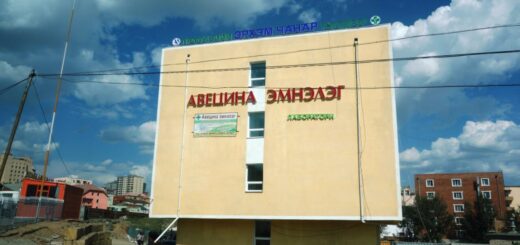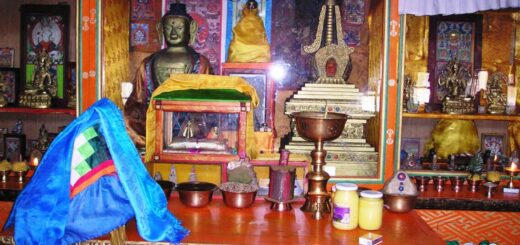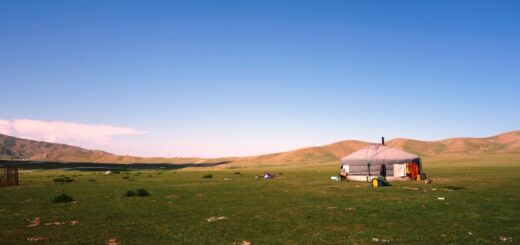World Heritage Sites in Mongolia
Mongolia, officially Mongolian Mongol Uls, state in Central Asia with (2019) 3.2 million residents; The capital is Ulan Bator.
Earthed
Erdenet, formerly Bayan Undur [ ba ʊ – ], second largest city of Mongolia, capital of the Aimak Orkhon, in the central north of the country; (2018) 99 500 residents.
University; Industrial complex with ore processing company for processing the copper-molybdenum ore extracted in open-cast mining on Erdentiin Owoo (Schatzberg), carpet industry; Branch line to the Trans-Mongolian Railway.
Darchan
Darchan, city in northern Mongolia, capital of Aimak Darchan (3 280 km 2), on the Trans- Mongolian railway line to Moscow and Beijing, (2018) 84 700 residents.
Developed as an industrial location in the 1960s, particularly with the help of the Soviets at the time; Coal mining; Food factories, compound feed factory, cement, leather factory.
Tschoibalsan
Tschoibalsan , Mongolian Choibalsan, until 1921 San-Beise, until 1941 Bayan-Tumen, city in eastern Mongolia, at Kerulen, capital of Aimak Dornod, (2018) 46 700 residents.
Wood, wool processing, food industry; at Tschoibalsan lignite mining; Road junction at the end of a railway line from Russia (Transbaikalia); Airfield.
Mörön
Mörön, Murun, city in northern Mongolia, on the Delger (headwaters of the Selenga), northwest of Ulan Bator, capital of Aimak Hövsgöl, (2018) 40 500 residents.
Livestock farming, vegetable and vegetable growing.
Uws-Nuur Basin (World Heritage)
The cross-border Mongolian-Russian world heritage includes the Uws-Nuur basin with a surface area of around 10,700 km² and the Great Salt Lake, the largest lake in Mongolia with an area of 3350 km². The basin is divided into twelve protected areas with different ecosystems. It is the habitat for seals, migrating and sea birds, polar cats and snow leopards.
Uws Nuur Basin: Facts
| Official title: | Uws-Nuur Basin |
| Natural monument: | Cross-border site with twelve protected areas of different ecosystems: eternal snow fields in the Turgen Mountains, lake and steppe areas, Altan Els desert, various forest areas; Total area 10,700 km²; named after the Uws Nuur salt lake, habitat for many migrating birds, seals and sea birds; Desert and mountain regions with rare animals, including Mongolian gerbils, polar cats, snow leopards, wild sheep, Asian ibex |
| Continent: | Asia |
| Country: | Mongolia, Russia |
| Location: | Uws-Nuur Basin |
| Appointment: | 2003 |
| Meaning: | Unique biosphere reserve |
Rock paintings in the Altai Mountains (World Heritage)
The rock carvings and tombs in the Altai Mountains give an insight into the cultural history of man in this region between 11,000 and 6,000 BC. BC and also illustrate the change in natural space from forest to steppe landscape, as a result of which a society based on nomadism and horse-keeping developed.
Rock paintings in the Altai Mountains: facts
| Official title: | Rock paintings in the Altai Mountains |
| Cultural monument: | Three to 11000 BC Sites with rock paintings and tombs in the Mongolian part of the Altai Mountains, which are over 4,000 m high; earliest rock carvings from the time of wooded mountains between 11000 and 6000 BC BC, mainly with hunting motifs; later rock paintings after the change of the Altai into a steppe area with herding as the predominant form of farming; Most recent drawings from the nomadic phase with depictions of horses and riders 1000 BC As well as from the Scythian and the late Turkic period (7th / 8th century AD) |
| Continent: | Asia |
| Country: | Mongolia |
| Location: | Ulaankhus, Tsengel, Bayan-Ulgii Province, Western Mongolia |
| Appointment: | 2011 |
| Meaning: | Unique, exceptionally well-preserved sources on prehistoric times and the history of civilization in Central and North Asia; outstanding examples of the phase of Northwest Mongolia as a cultural center in North Asia; impressive rock carvings of high complexity and quality as an authentic expression of human cultural history |
Holy Mountain Burkhan Khaldun (World Heritage)
According to legend, Genghis Khan was born here, and here he was buried at his own request: On the holy mountain Burkhan Khaldun, where the Central Asian steppe meets the coniferous forests of the Siberian taiga. Even before Genghis Khan was born in 1162, the mountain was considered sacred by the Mongols.
The over 2,300 meter high Burkhan Khaldun is representative of the worship of sacred mountains in Mongolia, of which there are another six. The ceremonies that have developed here take place preferably on rivers and on richly decorated piles of stones, so-called obos. One of them is on the top of Burkhan Khaldun. The cult acts arose from shamanic traditions, which were later supplemented by Buddhist elements.
In 1992, Mongolia designated the region around the mountain as a protected area and regularly performs state cult acts there.
In addition to sanctuaries in the form of obos, stone sculptures, inscriptions and temples are part of the world heritage site.
Holy Mountain Burkhan Khaldun: Facts
| Official title: | Holy mountain Burkhan Khaldun |
| Cultural monument: | 2300 meter high mountain with various historical cult and sacrificial sites, where shamanic and Buddhist traditions merge |
| Continent: | Asia |
| Country: | Mongolia |
| Location: | Burkhan Khaldun in Khentii Province in northeastern Mongolia, on the border with Russia; the mountain is part of the Khentii Mountains, which are up to 2800 meters high and stretch across the border with Russia. |
| Appointment: | 2015 |
| Meaning: | Symbol of the Mongol Empire around its most prominent representative Genghis Khan |
Daurian Landscapes (World Heritage)
Dauria, also known as Transbaikalia, stretches from eastern Mongolia to Russian Siberia and northeast China. The mountain landscape is named after the Dauren, who used to live in the transition area between steppe and forest areas.



